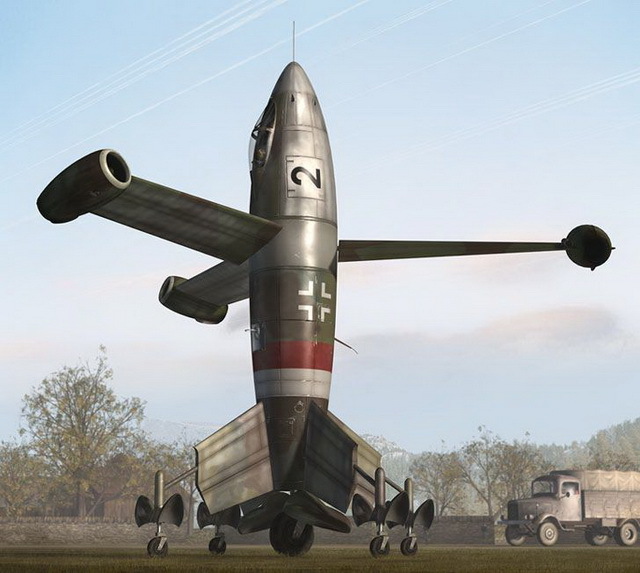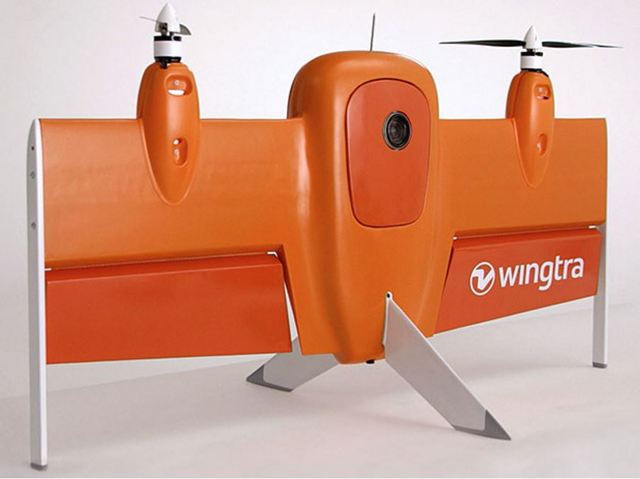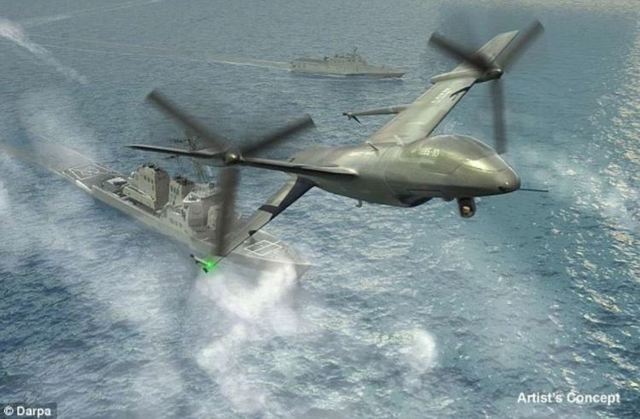Tailsitter - winged vertical take-off drone

The colossal advantage of quadrocopters and helicopter-type drones, associated with the absence of the need to organize a runway (runway), allows the latter to take off and land with high accuracy at almost any given point. Their weak link, in comparison with the fixed-wing drones “aircraft type” - a significant loss in energy efficiency. The latter, in the overwhelming majority, are also far from perfect - for take-off they will need a catapult or a rather long runway allowing them to gain sufficient take-off speed. An interesting alternative is to recognize tiltrotor - aircraft, having the ability to change the position of the propeller, wing, engine or louver to change the thrust vector from the vertical position at the time of takeoff and landing on the horizontal - in flight. Thus, with the energy efficiency of the UAV of an aircraft type, the tilt panes also retain the possibility of vertical takeoff, like drones and quadrocopters. However, the need to withstand the requirements of the concept significantly complicates and increases the cost of their design.
If most of us know about the first three types of UAVs, not all have heard about such an aircraft as Tailsitter.
The very idea underlying the principle of operation of the construction of tailsitters is far from new. So the concept of the vertical take-off and landing fighter Focke-Wulf Triebflügel was developed back in 1944 in Germany. Worked on the development of similar devices in the United States (Convair XFY Pogo) and in France (SNECMA Coléoptère). But in none of the countries listed above, manned aircraft of this type were widely distributed. Now, after more than seven decades, the idea, in its modified “unmanned” version, is again taking shape.
')

Focke-wulf triebflügel

Convair XFY Pogo

SNECMA Coléoptère
The main difference between a convertible and a tailsitter is that the design of the latter does not have turning elements. Therefore, in essence, tailsitter is a modified drone with a fixed wing and vertical takeoff. What a tailsitter “in action” looks like you can see on the TED video below (min. 1.50 ... 3.28).
Wingtra - this is the name of the company of the same name at the Swiss Technical School Zurich. On the launch pad, as can be seen in the figure below, the drone is held due to several anchor points — ribs extending from the tail and wings. It is this feature of the design that connects the UAV with its name: “tailsitter” (tailsitter), literally - “sitting on the tail”. Rising into the air on propellers, the device turns horizontally and goes along the air route like an airplane-type drone.

The Swiss model is equipped with a rechargeable battery, which lasts for an hour of flight at a distance of up to 60 km. Drone can pave the route at pre-planned points without the help of an operator. To make an autonomous landing, the device uses a camera built into the tail. Like the quadcopters we are familiar with, the Wingtra tailsitter is able to carry some payload. This could be, for example, equipment for inspection of agricultural land or power lines, medicines and other small-sized payload for various purposes. Wingtra expects to start mass production of the first series of telesitters by 2017.
It would be strange if everything connected with promising developments would not find a response from the engineers of the Middle Kingdom. One of the centers for the development of models of tailsters is the Design Institute for Aviation Engineering in Chendu. The first operating prototype, the tailsitter of the UAV VD 200 , was presented by the institute engineers back in 2013. The wingspan of the engine was almost 4.6 meters, weight - 200 kg, length, from the propeller - to the tail 1.8 m, diameter of the propellers - 2 meters, maximum speed of summer - 260 km / h, payload up to 20 kg, flight range - 150 km The permissible time of stay in the air is up to 3 hours.

UAV VD 200 (Reduced Copy)
The drone-tailsitter V-BAT , developed by the American company MLB with the support of DARPA, is able to stay in the air for 8 hours, travel at a speed of 83 km / h and rise to an altitude of 4.5 km. Retrofitting of the drone with a robotic arm to perform a number of simple tasks is allowed.
The range of V-BAT UAV capabilities is wide enough - from performing military attack missions, air patrols, search and target detection, aerial photography - to monitoring urban infrastructure, autonomous delivery and deployment of payload, supervision of agricultural and forest land, observation of wildlife habitat and so forth

V-BAT
The concept of the Tailsitter was the basis for the TERN project of the American company Northrop Grumman, which in 2015 received $ 93 from the DAPRA agency for the development of vertical take-off deck drones capable of turning almost any US Navy ship into some sort of strike aircraft carrier.

Thus, it is difficult to disagree that by combining the best qualities of an aircraft UAV and a helicopter type, the drones-testers got a number of unique advantages in comparison.
Tailsitter takeoff and flight. Prototype testing in the field
That's all, with you there was a simple service for choosing sophisticated Dronk.Ru equipment. Do not forget to subscribe to our blog , there will be many more interesting ...

LetyShops cashback service sponsor . Return money for any purchases on the Internet. Read more about what a cashback service is in our article. We choose a cashback service for the 6th anniversary of Aliexpress.
Source: https://habr.com/ru/post/394389/
All Articles